How the Royal Navy Was Fed - 1901
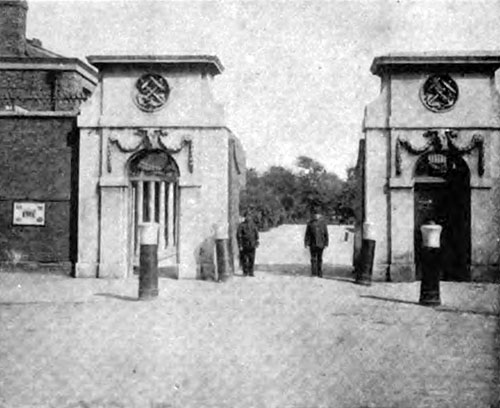
THE MAIN GATE OF THE ROYAL VICTUALLING YARD, DEPTFORD.
The Royal Victoria Yard is a big place with many different departments, although some of these concern themselves with the clothing and not the feeding of the hundred thousand men employed on her Majesty's ships.
The ground within its gates measures some thirty-five acres, but a good part of this is open space, and some of it is occupied by the dwelling-houses of the chief members of the staff.
Open space whereon temporary buildings could be erected is the first necessary provision against the emergency of war. In the meantime, this open space makes Deptford a pleasanter place of residence than it would otherwise be for the little colony of officials and their families.
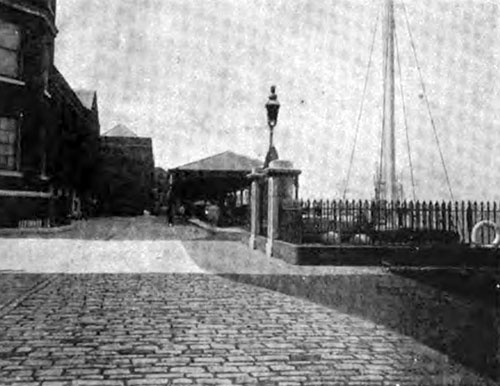
THE WATER GATE AND WHARF.
Rum is the only alcoholic liquor served out on board a man-of-war. The temperance has mostly advanced in the Navy, an ever-increasing number of men commuting their half a gill of rum per day into coin of the realm.
This fact is of some significance to the Chancellor of the Exchequer, a sum having to be provided by Parliament (last year it was about 10,000 Pounds) for the difference between the actual cost of the grog thus saved and the value with which abstainers are credited.
The actual cost to the Government of half a gill of rum, it seems, is represented by too fractional a figure. The rum is purchased by the Government at the prodigious strength of 40 degrees above proof and this has to be reduced to 4.5 degrees under proof.
This process is effected in thirty-two vats of enormous size, housed in specially constructed buildings along the riverside. They have a total capacity of 230,000 gallons, the largest holding 32,817 gallons.
This vat is two-thirds the size of the famous Heidelberg Tun, and, having regard to the far greater potency of its contents. From the vats, the rum is run into casks ready for dispatch to all parts of the world. The Government's purchases last year were exceptionally large in consequence of war scares.

BRASS GUNS ON THE WHARF AT THE ROYAL VICTUALLING YARD
One of these pieces was cast in 1638 in the presence of Charles I.
From rum, we turned to chocolate, its chief rival as the beverage of the Navy. About a million and a quarter pounds of chocolate is made here in the year, and trade experts have long regarded the Navy chocolate as the model for purity and quality.
The factory is equipped with machines and appliances; the process of manufacture (translating the cocoa-beans into the finished article), takes place only in the winter.
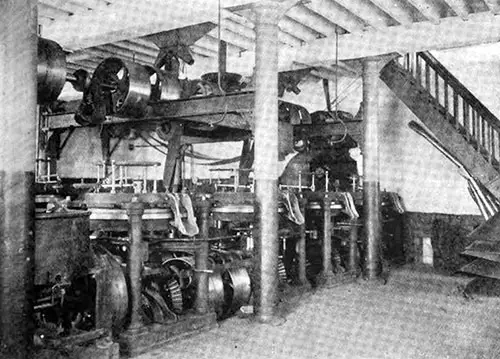
THE CHOCOLATE-MILLS.
As made for the Navy, the chocolate requires to be boiled several hours before it dissolves. A small quantity of the soluble kind with which housewives are familiar is prepared, however, for use on board ship at short notice when, after night exposure or in other unusual circumstances, Jack (a Navy man) receives a little extra comfort.
Lime-juice, of which a considerable quantity is stored at Deptford, is another beverage provided for Jack's comfort. It is mostly consumed in tropical climates, and its consumption is encouraged by officers because of its value as an antidote to scurvy.
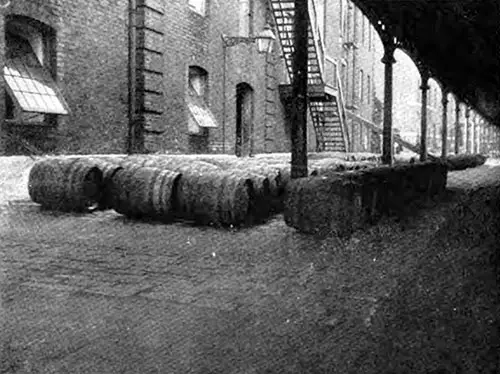
BARRELS OF RUM ON THE WHARF AWAITING SHIPMENT.
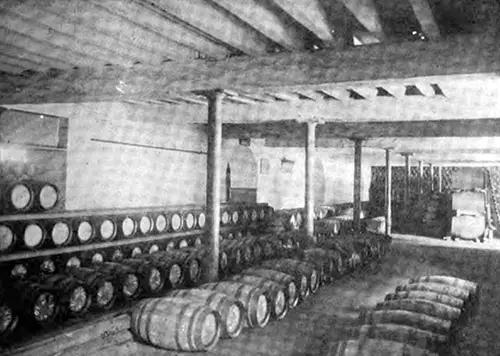
A CORNER OF THE RUM STORE.
As regards to eatables, salt junk is still the most important feature in Jack's dietary. The refrigerating-chambers, which have become universal on "liners," are still practically unknown on her Majesty's ships, and it is only for a day or two occasionally, after calling at a port, that fresh meat, vegetables, etc., can be enjoyed by their crews.
At one time, the cattle were killed at the Royal Victoria Yard, but the meat is now purchased from contractors. As it is, however, the huge meat stores form a remarkable feature of the place, beef, and pork being salted in barrels, which are placed in rows of ten. Into each barrel—containing 100 lb.—a little additional brine is inserted every day until it is hermetically sealed and ready for dispatch.
In a year, something like 2,000,000 lb. of beef and pork will probably pass through the Yard. The pork comes from Ireland and Denmark, the beef almost entirely from America.
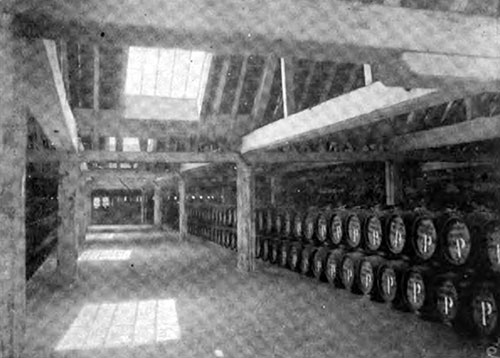
A PORTION OF THE SALT-MEAT STORE SHOWING BARRELS FILLED WITH SALT PORK.
The next range of buildings suggests that the sea-biscuit, like the salt junk, still flourishes as in the days of Nelson. In the production of this article, however, the Government is independent of the contractor.
The grain is bought on the open market, and ground into flour by mills at Deptford Yard, as well as at the victualling establishments of Portsmouth and Plymouth.
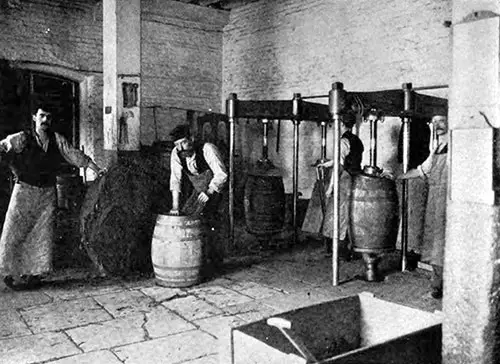
PACKING TOBACCO: SHOWING HOW TOBACCO IS PRESSED INTO THE BARRELS BY HYDRAULIC POWER.
First, there is a building of three floors in which the grain is stored in sacks. About 6,000 quarters, although the usual stock is little more than half that quantity, the Government having bought largely of late, because of the potential of the ships being put in commission and fresh supplies being difficult to obtain.
Biscuit-baking is not currently in operation; this industry, like manufacturing generally at the Yard, being confined to the winter months. The machinery was specially invented for the making of hexagonally shaped naval biscuits by a former employee at the Yard, who received a grant of £2,000 from the Government in recognition of his talent.
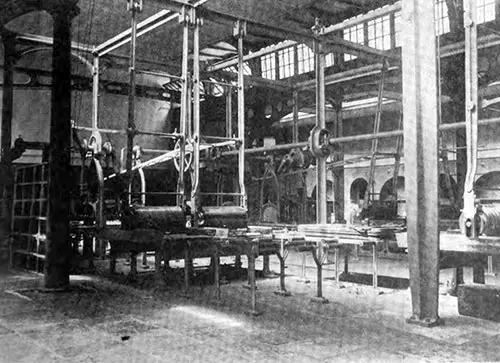
THE BISCUIT-BAKERY.
With the assistance of a dozen men, it will turn out 30,000 biscuits a day, each biscuit being stamped with the broad arrow as well as the letter "D," to indicate that it was made in the Deptford Yard. About 450 tons of biscuits will be produced in the year.
From each quarter of wheat about 1800 biscuits can be produced, and, accordingly, the Government has now stored at Deptford the material for something like eleven million biscuits. Working at full pressure, the Royal Victoria Yard alone, independent of the other victualling depots, could turn out sufficient biscuits to feed the entire Navy.
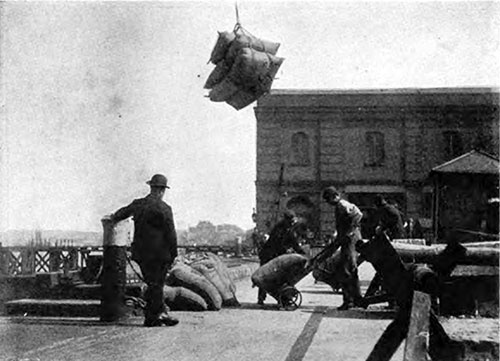
LOADING A LIGHTER WITH BAGS OF SUGAR.
In 1871, when Paris capitulated, the large reserves stored at the Yard enabled the Admiralty to render great service to the starving inhabitants of the unfortunate city. The capitulation took place on Feb. 8, and by the 10th 1,560 tons of provisions had been forwarded to Paris.
During the Egyptian War of 1882, the resources of the Yard were severely tried by the fact that the food for the Navy and Marines had to be specially packed for the Nile boats. But it stood the trial triumphantly, 400,000 rations so packed being sent in less than three weeks.
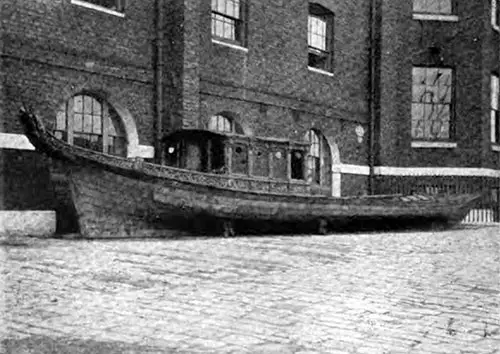
AN OLD ADMIRALTY BARGE.
Apart from such exceptional circumstances, only a big naval war could make a really exacting demand upon the establishment and its organization. Flour, meat, biscuits, cocoa, and rum — these form the chief constituents in a Navy man's dietary unless we are to include his indispensable tobacco in the category of food.
Tobacco, however, is not part of his rations, although he gets it duty-free, at the cheap rate of a shilling a pound, one pound a month is the maximum he can buy at home, and two pounds when on a foreign or colonial station.
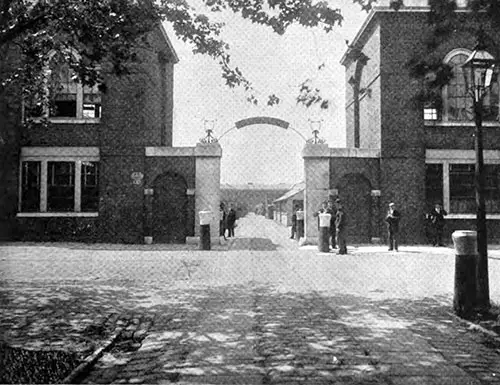
THE ENTRANCE TO THE COOPERAGE, ROYAL VICTUALLING YARD.
Other articles made or stored at Deptford include sugar, raisins, split peas, and drugs, the drug department being in charge of a Fleet-Surgeon in the Royal Navy.
The items of the different descriptions of stores in the Yard ran into thousands, including the minutiae of Jack's wardrobe as well as his larder and pantry. One large building is entirely devoted to the storage of kitchen utensils and the apparatus of the table.
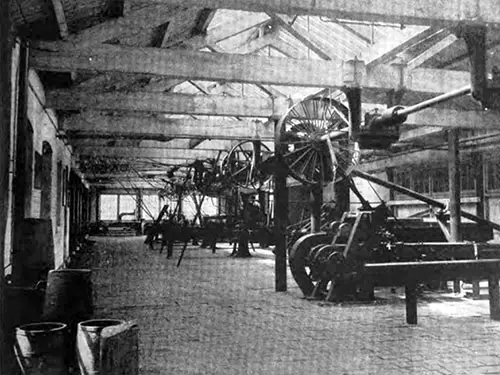
THE STEAM COOPERAGE.
The real simplicity of the bluejacket's diet is fully borne out on reference to the official rations table. According to the Naval and Military Record, this is as follows, the equivalents in money being also given:
. 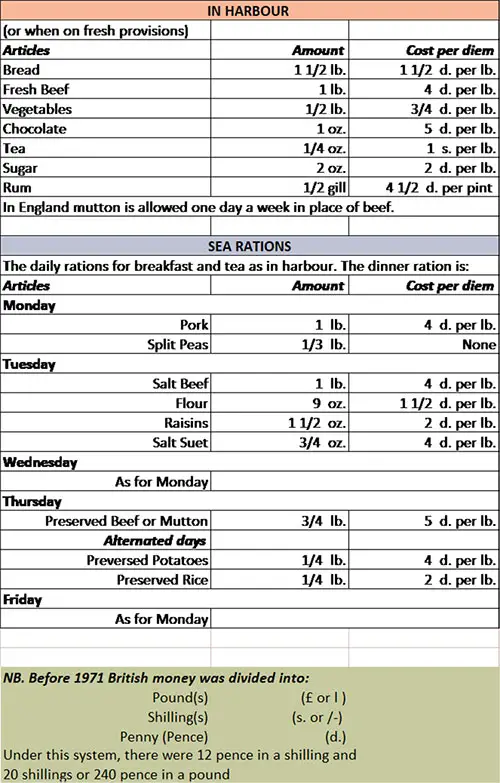
With the declining consumption of rum, tea and sugar are relative of increasing importance, and more and more space have to be devoted to the storage of these articles.
The sugar is the finest which Demerara produces and actually costs something like sixpence a pound; no bounty-fed beetroot ever comes into the Yard.
Besides the daily food, her Majesty's Navy has to be furnished from Deptford with a considerable quantity of medical comforts. The long official list with this heading includes port wine, beef essence, oxtail soup, chicken broth, calf's foot jelly, preserved milk, and preserved fowl.
Port wine has also to be furnished for use at Communion services. It is bottled for this purpose in quarter-pints as a precaution against misuse. At one time a pint bottle would often have to be uncorked for two or three communicants, but this was obviously so productive of waste that the quarter-pint bottle was introduced.
The wine drunk at the officers' table is, of course, obtained at their own cost, in the same way, that the wine at a regimental mess is subscribed for.
Provisions are ordered direct from Deptford or one of the other victualling yards by the officers of each ship when in port.
These demands are, of course, regulated by a scale based upon the number of the crew, and the Victualling Yard officials would report any excess to the Director of Victualling at the Admiralty.
At one time the supervision was in the hands of a Victualling Commission, and they can still show you at Deptford the gorgeous barge in which the Commissioners traveled from Westminster on their visits of inspection—an interesting relic worthy of some better fate than that which exposure to the weather is preparing for it.
Supplies for ships are mostly sent down to Sheerness by water, two tugs being employed continuously in the towage of lighters; supplies for foreign stations are usually sent out as ordinary freight.
A branch of the London and Brighton Railway facilitates the speedy consignment of goods to one of the other victualling yards, or to any of the ports of the country.
Having realized the magnitude of its scope, it speaks well for the administration that only about five hundred men are regularly employed at the Royal Victoria Yard.
Apart from manufacturing, the chief work is in the nature of packing, and the same men are engaged indifferently in both. The cooperage, in which all the wooden paraphernalia of the ship's kitchen are made, employs the largest proportion of hands all the year round.
The workmen generally are under the control of the Superintendent of the Yard, but each department of labor— baking, cocoa-making, rum-distilling, etc.—has, of course, its skilled foreman.
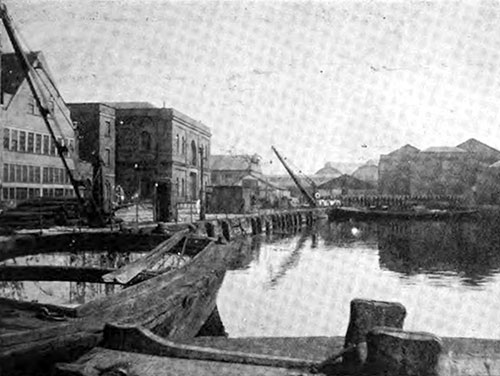
THE MAST POND AND STORES
Deptford strikes a suburban stranger as dingy and prosaic to a degree exceptional even in London. But apart from the interest and importance of its present-day function, that part of its space occupied by the Victualling Yard has associations and memories such as might be envied by many a more pretentious district.
For centuries a shipbuilding establishment, it may almost be said to have been the cradle of the Navy in Elizabethan times and was subsequently the scene of many a stirring episode in its history.
Kings and princes visited it to launch some of the finest craft which has done battle for England's sea power. More than one famous expedition of peace or war sailed from Deptford; and as an inscription today reminds us, it was here that Peter the Great worked as a ship's carpenter.
The historical spirit which may thus be said to pervade the place has been well expressed in Sir Walter Besant's novel, "The World Went Very Well Then."
Frederick Dolman, "How The Navy is Fed: A Visit to the Principal Victualling Yard," in The English Illustrated Magazine, London: Ingram Brothers, Vol. XXIV, No. 1, October 1900, p. 8-17
